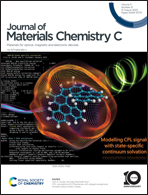A first-principles study of quaternary thioiodides for stable lead-free solar cells†
Abstract
Organic–inorganic hybrid halide perovskites have recently attracted enormous interest as photovoltaic materials because of their superior solar cell performance and straightforward fabrication. Unfortunately, the poor stability and the Pb-related toxicity still hinder their commercialization. Quaternary thioiodides, owing to their ns2 lone pair cations and stronger metal–chalcogen bonds, possess suitable bandgaps, high permittivity, and good stability. Herein, we proposed a series of quaternary thioiodide materials, M22+M3+S2I3 (M2+ = Ca, Sr, Ba, Zn, Cd, Cu, Ti, and Sn; M3+ = Bi, Sb, and In), to solve these problems. Based on first-principles calculations, we confirm four potentially superior photovoltaic materials with suitable solar cell band gaps, high permittivity, low effective masses, and low exciton binding energies. In addition, the calculations predict that these materials possess superior optical absorption properties. Especially, the theoretical spectroscopic limited maximal efficiency of Sn2InS2I3 is over 33%. This study establishes the possibility of the use of lead-free quaternary thioiodides in photovoltaic materials.



 Please wait while we load your content...
Please wait while we load your content...